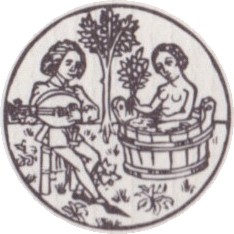
rondellus.ee
RS Records, RS 9503
1995
Secular Music in France, XIVth–XVth century
/ Rondellus
Machaut, Dufay, Binchois and anonymous

rondellus.ee
RS Records, RS 9503
1995
Side A (total time; 23:50)
Guillaume de Machaut (1300/05 - 1377)
1. Amours me fait desirer [4:47]
voice MS, portative organ, fiddle
2. De tout sui si confortee [1:57]
fiddle, lute
3. Dame, se vous m'estes [4:37]
voice MS, fiddle, symphony, percussion
4. Je ne cuit pas [3:54]
voice MS, lute
5. Moult sui de bonne heure nee [1:51]
lute, fiddle, percussion
6. Quant ma dame [2:58]
voice MS, fiddle, lute
7. Quant je sui mis au retour [3:07]
voice MS, fiddle, symphony, percussion
Side B (Total time 23:10)
Anonymous
1. Contre le temps/Hé mari, mari! [2:23]
voices MS VK, fiddle
2. Je voy le bon tens [2:24]
portative organ
Guillaume Dufay (c.1400-1474)
3. Bon jour, bon mois [4:04]
voices MS VK, fiddle, lute
4. Navré je sui d'un dart penetratif [3:15]
voice MS, fiddle, lute
5. J'ay mis mon cuer [1:14]
voices MS VK, fiddle, lute
Anonymous
6. Tant qu'en mon cuer/Sur l'erbette [1:50]
portative organ
7. Ho, ho, ho! [2:19]
voices MS VK, fiddle, percussion
8. Je voy mon cuer [1:28]
voices MS VK, harp, lute
Gilles Binchois (c. 1400-1460)
9. Files a marier [0:47]
voices MS VK, fiddle, lute
10. Dueil angoisseus [2:05]
voice MS, fiddle, lute

RONDELLUS
Maria Staak, vocalist
Veikko Kiiver, vocalist
Marju Riisikamp, portative organ
Peeter Klaas, fiddle, harp
Robert Staak, lute, symphony
Riho Ridbeck, percussion
Recording engineer: Maido Maadik
Producer: Robert Staak
Design: Iris Kottri
℗ © Estonian Broadcasting Company & RS Records Ltd 1995

With
the banning of motets from religious services in 13th century France,
polyphonic scholarly composition would no longer be the privilege of the
church. By 1300, polished forms of poetry had emerged in French secular
song, but there were rarely composed polyphonically, using instead a
very simple style. The breakthrough which occurred in secular song in
the 14th century marks the beginning on the renaissance in music. The
strict textual forms (formes fixes: rondeau, virelai and ballade) of trouvere song were adopted and like the motets, were integrated with the complicated style of ars nova.
These song compared to the rationally, at times altogether
mathematically, composed motets, had a much freer and more serious
composition, using an imaginatively embellished upper voice (discantus) as the principal voice.
Polyphonic
secular song first rose to prominence through the composition of
GUILLAUME DE MACHAUT (1300/05 - 1337). Despite being a member of the
clergy, religious composition was clearly of secondary importance in his
work. Machaut was one of the great poets of his century and his
emphatically personal, often autobiographical love poetry can be
regarded as purely renaissance. A new and personal expression of emotion
is equally perceptible in his music, even when the rational side of the
composition is impeccably polished.
The second height of French
song is related to the rise of the Franco-Flemish school in the first
half of the 15th century. Of particular importance to the emergence of
this new style were its first great masters, GUILLAUME DUFAY (ca. 1400 -
1474) and GILLES BINCHOIS (ca. 1400 - 1460). The novelty and power of
French ars nova lives on in both of their work, but with the additional influence of a new English style, countenance angloise, on which la nouvelle pratique de faire fresque concordance
(new method of creating novel concordance) was based, as this new
style was described by the French poet Martin le Franc in his poem Le Champion des Dames
(1440). Dufay spent his formative years in Italy, where he was
influenced by the emotional and flowing melodies of Italian song. These
two composers form an interesting contrasting pair. While Dufay is
representative of the classic musical scholar of cleric education,
Binchois is usually portrayed as a simple soldier, who became a singer
of the Burgundian court chapel. There is a great deal in common in their
composition, yet Dufay's music is clearly more finely polished while
Binchois's enchants with his simple and powerful expression.
Toomas Siitan